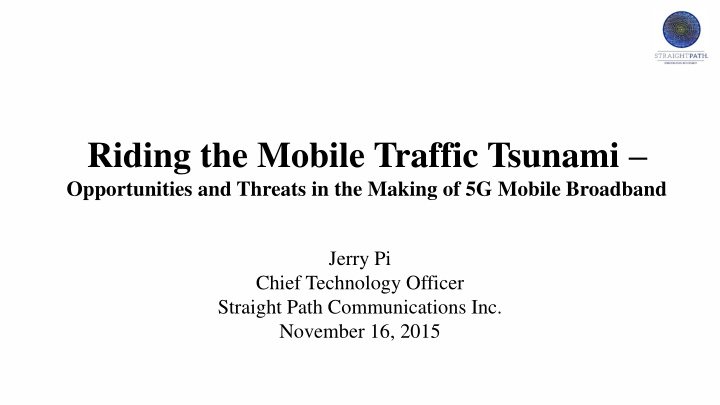



Riding the Mobile Traffic Tsunami – Opportunities and Threats in the Making of 5G Mobile Broadband Jerry Pi Chief Technology Officer Straight Path Communications Inc. November 16, 2015
Content Drives Demand for Capacity 360 o /VR 4K/8K SD/HD More usage More apps More users Video to drive >60% of mobile traffic 2
Commerce Drives Demand for Availability Commerce to generate >70% of mobile Internet revenue Expansion New biz of enabled by eCommerce mobile Mobile Commerce 3
New Possibilities for Disruption Mobile IoT 5G Core Value Gbps Technology Disruption • Mobile Broadband • Transportation • Cameras & sensors • Retail • Signal processing • Service Mobility • Intelligence • Lifestyle Example – Autonomous Vehicles 4
Cellular Between a Rock and a Hard Place Mobile traffic grows at 60% CAGR The widening traffic revenue gap Traffic Traditional cellular spectrum <6 5G must achieve GHz – not enough nor much lower cost/bit than 4G economically viable to meet the growing mobile broadband Revenue demand Voice Mobile Broadband 5G in millimeter wave frequencies • 2010 – Two fundamental concepts (Millimeter-wave Mobile Communication & Massive MIMO) • Significant technology milestones – NTT DoCoMo (’13), Samsung (’13, ’14), Ericsson (’14), Nokia (’14) • Feasibility corroborated by extensive channel measurement studies ( e.g. , Rappaport in UT and NYU) • Recognized as one of the core technologies for 5G in global standardization bodies Overarching 5G goals can only be met with multi-gigahertz millimeter wave spectrum • 1000x capacity increase over 4G, wide-area Gbps mobility, 1 ms latency 5
Straight Path 5G Vision Typical Value LTE R8 5G Gbps Mobility 20 MHz 500 MHz Bandwidth 2.5 bits 10 bits Sector Spectral Efficiency Wide area 150 Mbps 20 Gbps Cell throughput Gbps user (3-sector) (4-sector) cellular experience networks ~1 Mbps ~100 Mbps Cell-edge throughput 50%-tile ~10 Mbps ~1 Gbps Multi-Gbps Vehicle- throughput cell speed 100 m – 10 100 m – 1 Outdoor cell throughput mobility km km radius 6
A Sea Change Upon the Entire Ecosystem Services 10 ~ 100 Mbps 1 ~ 10 Gbps Applications Devices $10 ~ $100 / GB $0.1 ~ $1 / GB Networks 1 ~ 10 antennas 10 ~ 1000 antennas Baseband Transceivers 0.6 ~ 6 GHz 6 ~ 60 GHz Components Opportunities? Threats? 7
Transceivers & Components Integration Depth Integration RF ANT LNA Phase Shifter VGA RF RF • Front End SW SW Integration Breadth RF • Power ANT Mixer PA VGA • Amplification Combiner RF • RFIC ANT LNA VGA RF LO RF RF • Phase Shifting SW SW RF • Mixing Phase Shifter ANT PA VGA • Combining Integration Depth Efficiency RF LNA ANT Integration Phase Shifter VGA • Power Efficiency Breadth RF RF SW SW • PA class RF Mixer PA ANT VGA • Fabrication process Combiner • Linearization RF ANT LNA VGA RF LO • Analog Pre-Distortion RF RF SW SW • Average Power Tracking RF Phase Shifter ANT PA VGA 8
Baseband & Air Interface • 150 – 160 dB link budget Coverage Beamformed Control • 100 m – 1km cell radii • 100 MHz – 1 GHz system bandwidth Capacity Massive MIMO • 100 MHz cell edge, 1 Gbps typical, >10 Gbps peak • Wide area coverage Mobility Beamformed MAC • Vehicular speed 9
5G Network – Outdoor & Indoor Outdoor • Small base station (laptop size) with high EIRP (~60 dBm) • Large footprint (up to 1km in urban area, >1 km in suburban and rural areas) • Higher deployment density than 4G with same CAPEX/OPEX • Higher antenna gain at BS & MS increases SNR • Directional transmission reduces interference Indoor • 10 – 20 dB higher EIRP and much larger footprint than Wi-Fi Access Point (with same size) • Less congested spectrum and lower interference than Wi-Fi • Enclosed space often leads to LOS propagation loss less than free space • Manageable penetration loss for most building interior materials 10
5G Network – Outside-in Highly directional at base station How it works Scattered at mobile station • Higher EIRP (>60 dBm) • Higher deployment density (with same CAPEX/OPEX as 4G) • Higher antenna gain at BS & MS • Reduced inter-cell interference • Less penetration loss with small windows, small openings, re- bar • Meaningful penetration through brick and concrete 1, 2 • Penetration loss of interior materials generally small 1, 2 • Promising preliminary results 3 1. NTIA Report 94-306 , “Building penetration loss measurements at 900 MHz, 11.4 GHz, and 28.8 GHz” 2. NTIA Report 88-239 , “Millimeter -wave propagation characteristics and channel performance for urban- suburban environments” 3. "Millimeter-wave beamforming as an enabling technology for 5G cellular communications: theoretical feasibility and prototype results," in Communications Magazine, 10 IEEE , vol.52, no.2, pp.106-113, February 2014
Penetration Loss based on NTIA report Penetration loss in 28.8 GHz vs. 0.9 GHz 28.8 GHz less impeded by • 7 dB more for “Residential” (wood frame with small windows than 0.9 GHz brick veneer) • 17 dB more for “Radio Building” (concrete wall with steel reinforcement) • 7 dB less for “Store Room” (metal siding with window) 1. NTIA Report 94-306 , “Building penetration loss measurements at 900 MHz, 11.4 GHz, and 28.8 GHz ” 11
Make 5G happen or let 5G happen to you 12
Recommend
More recommend